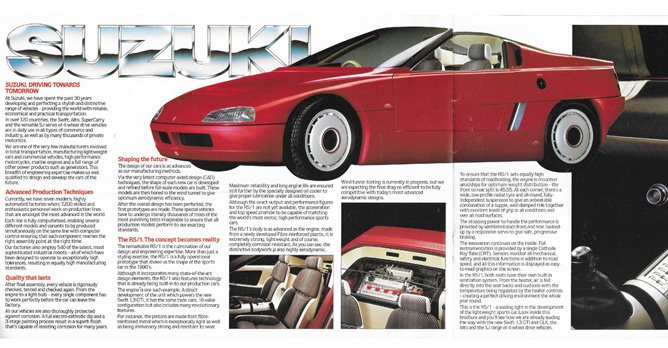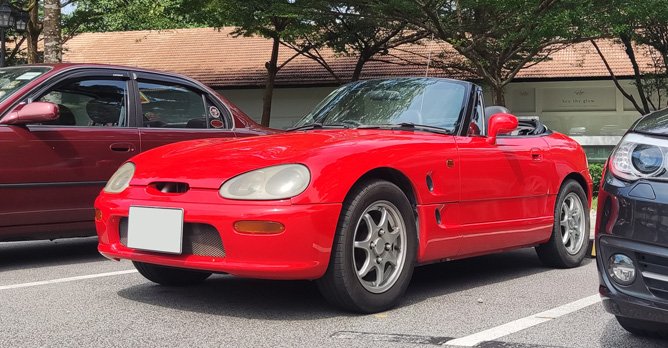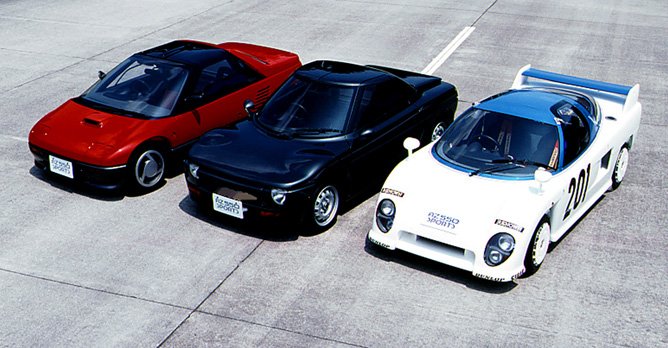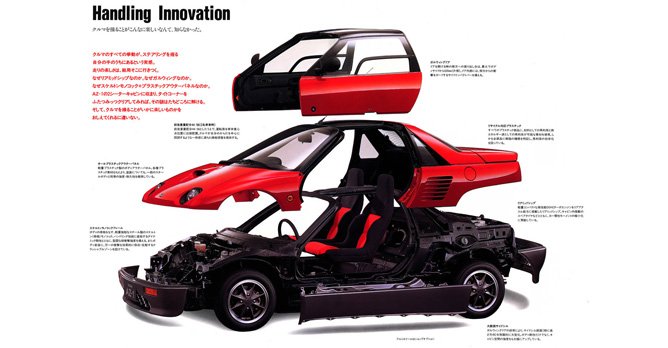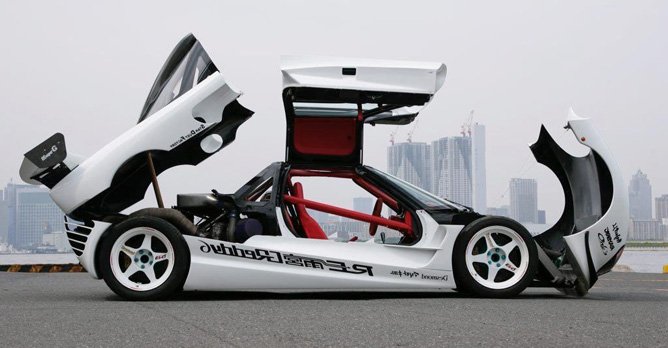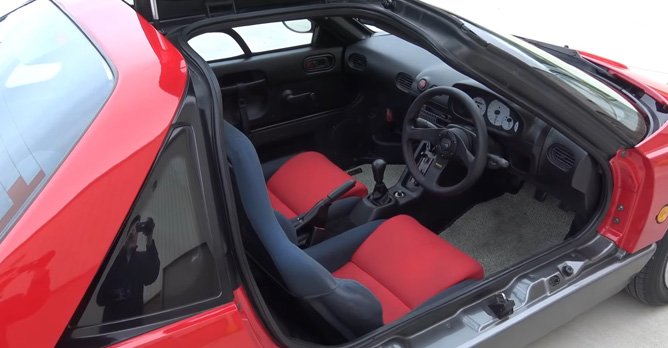Motoring Icons: JDM Legends - Mazda Autozam AZ-1
08 Jun 2023|10,500 views
The original Mercedes-Benz SL300 or the later SLS will probably be the cars that cross your mind when someone mentions gullwing doors. Now, what if I told you there's something else that is arguably as iconic, and it also has a fancy pair of doors?
Yes, it is the miniscule Mazda Autozam AZ-1! What is the AZ-1, you wonder? Well, it is a Japanese 'Kei-class' compact sports car that we never got here in Singapore. Any JDM enthusiast will know the existence of Kei cars, and anyone that has even briefly researched them will know the 'ABC' trio of Kei sports cars. The AZ-1 that the 'A' stood for was a truly special car, and it isn't just those intriguing doors - the AZ-1 has many more interesting bits that you'll want to learn about!
Powertrain:
Engine: Suzuki 660cc in-line three F6A Twin-Cam Turbocharged
Horsepower: 63bhp at 6,500rpm
Torque: 85Nm at 4,000rpm
Drivetrain layout: Mid-engine, Rear-wheel drive
History of the AZ-1 - Mazda completed the project that Suzuki started off
But before we get into it, I know, you are wondering what even is an 'Autozam'. Autozam was a brand by Mazda that specialised in small cars, and naturally, the AZ-1 was launched under it.
However, tracing the roots of the Autozam AZ-1 will lead you to Suzuki, which was the company that actually started the ball rolling with its RS-1 concept car that was made in 1985.
The Suzuki RS-1 was an advanced concept car that utilised fibre-reinforced plastic and had a mid-mounted engine (like most supercars) for optimal weight distribution.
It was eventually developed into the RS-3 concept in 1987, before the company decided to abandon the project in favour of the Suzuki Cappuccino. It was at this point that Mazda took over the project that resulted in the birth of the Autozam AZ-1.
When Mazda took over, its design team, led by the same man who was responsible for the wildly successful MX-5, was tasked to work on the AZ project.
This effort led to the AZ-550 Sports, which truly pushed the envelope in sports car design.
The AZ-550 Sports prototypes were created during a period where the Kei car regulations dictated a maximum engine capacity of 550cc, which was why the prototypes were named as such.
Constructed with a space frame chassis, along with floors and bulkheads made from aluminium honeycomb, the AZ-550 was dressed in three distinctly different body styles that were made from fibreglass - namely Type A, B and C.
Type A was the design that looked almost identical to the eventual AZ-1 (except it had a pair of pop-up head lights), Type B was a rather quirky design with massive head lights, while Type C had a body that was inspired by Mazda's Group C sports prototype racers. Interestingly, the Autozam AZ-1's connection with Suzuki did not simply ended at the concept stages - the AZ-1 was also sold as the Suzuki Cara with minute differences between the two.
Allure - An affordable mid-engine sports car marketed as the 'ultimate handling machine'

If you have been reading keenly thus far, you would already have an idea as to why the Autozam AZ-1 is as desirable as it is.
But, I'll reiterate it all for you, the AZ-1 is a compact, low-slung sports car that has a turbocharged engine located in the same position and powering the same wheels as supercars.
In fact, it even has the looks of one - the side strakes are inspired by the Ferrari Testarossa, the sectioned side windows are reminiscent of race cars with Perspex lightweight windows, it has gullwing doors like the SL300, and a sleek side profile and rear end that I personally find reminiscent of the Mclaren F1!
With its miniscule size and the use of lightweight materials - the body panels were made of injection molded plastic - the AZ-1 weighs in at a feather-light 720kg.
Combine this with a peppy little engine located between the driver and the rear wheels, and a low driving position, there's no question that this is about as close as a go-kart experience that you can get in a full-sized car.
It isn't difficult to see why it was once marketed as the 'ultimate handling machine'.
Being a Kei-class car, the Autozam AZ-1 was rather affordable when compared to other larger sports cars. However, it was still the costliest among its peers in the era, the Honda Beat and the Suzuki Cappuccino (the 'B' and 'C' in the Kei car ABC trio).
As a result, Mazda only managed to produce 4,392 units of the Autozam AZ-1 between 1992 and 1994, which was much fewer than a total of over 60,000 units of Cappuccinos and Beats that were produced.
Consequently, the Autozam AZ-1 became the rarest of the iconic Kei sports car trio and remains highly sought after. Adding to the hype is the fact that Kei cars are meant for Japan's domestic market, and are fresh and intriguing to car enthusiasts the world over.
Cultural significance - the little supercar that could
From the various modified examples that you can see on the internet, it is clear the AZ-1 has a place in the hearts of car enthusiasts.
Being extremely lightweight, it doesn't take much for the AZ-1 to go fast. While its engine originally produced a paltry 63bhp, it was reported that with some fettling, doubling its output was well within reach.
Once the AZ-1 was tuned up, it becomes a tiny yet zippy and potent track machine that offers plenty of fun driving experiences.
The love for the AZ-1 can be seen from the multitudes of interesting, modified examples.
There was a notable example that was modified to look like a mini-me Ferrari F40, and on the extreme end of the spectrum is the RE-Amemiya GReddy VI-AZ1.
The RE-Amemiya modified AZ-1 is a widened and elongated AZ-1 that has been extensively reworked.
According to online sources, the car was equipped with a turbocharged Mazda 20B three-rotor engine that puts out more than 400bhp. Along with the ludicrous engine are brakes from the Ferrari F50 and the transmission, differential and suspension from the Porsche 962C.
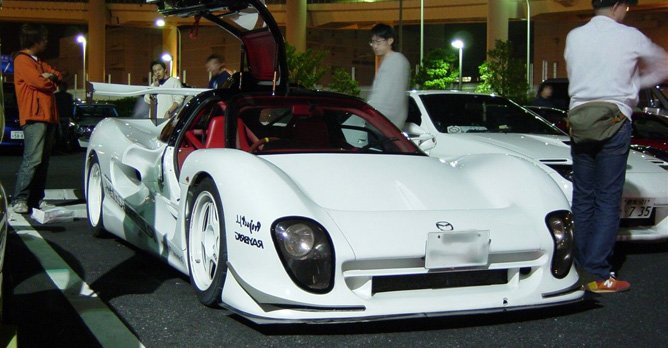
In my opinion, this radically modified AZ-1 is one of the best-looking creations, and is something that I can only dream to have a go in.
For all of us that aren't situated within Japan, the closest we can get to the AZ-1 would be the various games that feature the car.
I was introduced to this gem of a car through Sega GT, a racing simulator on Sega's Dreamcast console.
Unsurprisingly, the Mazda Autozam AZ-1 is also featured in the Gran Turismo series.
Before you buy - Getting hold of one wont be easy!
As there aren't any known examples of the Mazda Autozam AZ-1 in Singapore, there's no hope in getting one that is registered under the normal vehicle scheme that would allow you to daily the car.
Hence, the only way to get one would be to source for it overseas, likely from Japan, and import it into Singapore. Even then, you will have to wait till 2027 to register it under the Classic Vehicle Scheme.
Due to the rarity of the AZ-1, you would probably want to source for one before its prices further appreciate. And in my opinion, being such a unique offering, I think it would be a truly interesting and different classic car to have. I sure would love to see one running about on Singapore roads.
Enjoyed reading about the iconic Mazda Autozam AZ-1? Here are some other articles that you might be interested in:
Motoring icons: JDM legends - Honda Civic VTi/SiR (EG6)
These old but gold JDM cars are more expensive than your brand new European luxury machines!
We found 10 cool-looking Japanese car modifications right here in Singapore!
The original Mercedes-Benz SL300 or the later SLS will probably be the cars that cross your mind when someone mentions gullwing doors. Now, what if I told you there's something else that is arguably as iconic, and it also has a fancy pair of doors?
Yes, it is the miniscule Mazda Autozam AZ-1! What is the AZ-1, you wonder? Well, it is a Japanese 'Kei-class' compact sports car that we never got here in Singapore. Any JDM enthusiast will know the existence of Kei cars, and anyone that has even briefly researched them will know the 'ABC' trio of Kei sports cars. The AZ-1 that the 'A' stood for was a truly special car, and it isn't just those intriguing doors - the AZ-1 has many more interesting bits that you'll want to learn about!
Powertrain:
Engine: Suzuki 660cc in-line three F6A Twin-Cam Turbocharged
Horsepower: 63bhp at 6,500rpm
Torque: 85Nm at 4,000rpm
Drivetrain layout: Mid-engine, Rear-wheel drive
History of the AZ-1 - Mazda completed the project that Suzuki started off
But before we get into it, I know, you are wondering what even is an 'Autozam'. Autozam was a brand by Mazda that specialised in small cars, and naturally, the AZ-1 was launched under it.
However, tracing the roots of the Autozam AZ-1 will lead you to Suzuki, which was the company that actually started the ball rolling with its RS-1 concept car that was made in 1985.
The Suzuki RS-1 was an advanced concept car that utilised fibre-reinforced plastic and had a mid-mounted engine (like most supercars) for optimal weight distribution.
It was eventually developed into the RS-3 concept in 1987, before the company decided to abandon the project in favour of the Suzuki Cappuccino. It was at this point that Mazda took over the project that resulted in the birth of the Autozam AZ-1.
When Mazda took over, its design team, led by the same man who was responsible for the wildly successful MX-5, was tasked to work on the AZ project.
This effort led to the AZ-550 Sports, which truly pushed the envelope in sports car design.
The AZ-550 Sports prototypes were created during a period where the Kei car regulations dictated a maximum engine capacity of 550cc, which was why the prototypes were named as such.
Constructed with a space frame chassis, along with floors and bulkheads made from aluminium honeycomb, the AZ-550 was dressed in three distinctly different body styles that were made from fibreglass - namely Type A, B and C.
Type A was the design that looked almost identical to the eventual AZ-1 (except it had a pair of pop-up head lights), Type B was a rather quirky design with massive head lights, while Type C had a body that was inspired by Mazda's Group C sports prototype racers. Interestingly, the Autozam AZ-1's connection with Suzuki did not simply ended at the concept stages - the AZ-1 was also sold as the Suzuki Cara with minute differences between the two.
Allure - An affordable mid-engine sports car marketed as the 'ultimate handling machine'

If you have been reading keenly thus far, you would already have an idea as to why the Autozam AZ-1 is as desirable as it is.
But, I'll reiterate it all for you, the AZ-1 is a compact, low-slung sports car that has a turbocharged engine located in the same position and powering the same wheels as supercars.
In fact, it even has the looks of one - the side strakes are inspired by the Ferrari Testarossa, the sectioned side windows are reminiscent of race cars with Perspex lightweight windows, it has gullwing doors like the SL300, and a sleek side profile and rear end that I personally find reminiscent of the Mclaren F1!
With its miniscule size and the use of lightweight materials - the body panels were made of injection molded plastic - the AZ-1 weighs in at a feather-light 720kg.
Combine this with a peppy little engine located between the driver and the rear wheels, and a low driving position, there's no question that this is about as close as a go-kart experience that you can get in a full-sized car.
It isn't difficult to see why it was once marketed as the 'ultimate handling machine'.
Being a Kei-class car, the Autozam AZ-1 was rather affordable when compared to other larger sports cars. However, it was still the costliest among its peers in the era, the Honda Beat and the Suzuki Cappuccino (the 'B' and 'C' in the Kei car ABC trio).
As a result, Mazda only managed to produce 4,392 units of the Autozam AZ-1 between 1992 and 1994, which was much fewer than a total of over 60,000 units of Cappuccinos and Beats that were produced.
Consequently, the Autozam AZ-1 became the rarest of the iconic Kei sports car trio and remains highly sought after. Adding to the hype is the fact that Kei cars are meant for Japan's domestic market, and are fresh and intriguing to car enthusiasts the world over.
Cultural significance - the little supercar that could
From the various modified examples that you can see on the internet, it is clear the AZ-1 has a place in the hearts of car enthusiasts.
Being extremely lightweight, it doesn't take much for the AZ-1 to go fast. While its engine originally produced a paltry 63bhp, it was reported that with some fettling, doubling its output was well within reach.
Once the AZ-1 was tuned up, it becomes a tiny yet zippy and potent track machine that offers plenty of fun driving experiences.
The love for the AZ-1 can be seen from the multitudes of interesting, modified examples.
There was a notable example that was modified to look like a mini-me Ferrari F40, and on the extreme end of the spectrum is the RE-Amemiya GReddy VI-AZ1.
The RE-Amemiya modified AZ-1 is a widened and elongated AZ-1 that has been extensively reworked.
According to online sources, the car was equipped with a turbocharged Mazda 20B three-rotor engine that puts out more than 400bhp. Along with the ludicrous engine are brakes from the Ferrari F50 and the transmission, differential and suspension from the Porsche 962C.

In my opinion, this radically modified AZ-1 is one of the best-looking creations, and is something that I can only dream to have a go in.
For all of us that aren't situated within Japan, the closest we can get to the AZ-1 would be the various games that feature the car.
I was introduced to this gem of a car through Sega GT, a racing simulator on Sega's Dreamcast console.
Unsurprisingly, the Mazda Autozam AZ-1 is also featured in the Gran Turismo series.
Before you buy - Getting hold of one wont be easy!
As there aren't any known examples of the Mazda Autozam AZ-1 in Singapore, there's no hope in getting one that is registered under the normal vehicle scheme that would allow you to daily the car.
Hence, the only way to get one would be to source for it overseas, likely from Japan, and import it into Singapore. Even then, you will have to wait till 2027 to register it under the Classic Vehicle Scheme.
Due to the rarity of the AZ-1, you would probably want to source for one before its prices further appreciate. And in my opinion, being such a unique offering, I think it would be a truly interesting and different classic car to have. I sure would love to see one running about on Singapore roads.
Enjoyed reading about the iconic Mazda Autozam AZ-1? Here are some other articles that you might be interested in:
Motoring icons: JDM legends - Honda Civic VTi/SiR (EG6)
These old but gold JDM cars are more expensive than your brand new European luxury machines!
We found 10 cool-looking Japanese car modifications right here in Singapore!
Thank You For Your Subscription.













